All Issues
Dairy workers learn husbandry, management skills
Publication Information
California Agriculture 58(3):135-136.
Published July 01, 2004
PDF | Citation | Permissions
Full text
While California is the top milk-producing state nationwide, many workers in the state's 2,125 dairies lack basic husbandry skills. In addition, as dairies have gotten larger, the dairy herdsman's role has grown to include training and managing other employees. “California dairies are getting so intricate that employees need state-of-the-art training,” says Gerald Higginbotham, UC Cooperative Extension (UCCE) dairy advisor.
To help meet this need, UCCE dairy advisors and specialists established the Dairy Herdsman Short-course. Higginbotham coordinates the program, which was developed with input from the California State University (Fresno and Chico), UC School of Veterinary Medicine, California Animal Health and Diagnostic Laboratory, and dairy producers. Five short courses have been held since 2001 for about 170 dairy employees.
Students in UC Cooperative Extension's dairy herdsmen short course receive state-of-the art training in basic husbandry and dairy herd management. Gerry Sanchez (with stethoscope) listens for the heart and lung sounds of a dairy cow at the California State University, Fresno, dairy farm.
UC Cooperative Extension dairy specialist Steven Berry discusses tools used in the proper care of cow hoofs.
The Dairy Herdsman Shortcourse spans 3 days, with lectures in the mornings and hands-on laboratories in the afternoons. Because many Western dairy workers are Latino, the short course presentations are simultaneously translated into Spanish. Participants receive a notebook with the lectures and presentations, a California Mastitis Kit, a stethoscope and one colostrometer per dairy.
The short course covers dairy management, basic dairy husbandry and the latest in dairy practices. The management sessions include the use of herd-management software as well as labor management, from selecting to evaluating and disciplining employees.
The husbandry lectures include reproductive anatomy; milking and troubleshooting milk-quality problems; and herd health, such as nutrition and diagnosing diseases like mastitis and Johne's disease. The husbandry labs include assessing cow health from heart and lung sounds, proper hoof trimming and a calf autopsy. The most recent short course also had a lab on difficult calvings, in which participants learned how to manipulate calves into a normal position.
The sessions on the latest in dairy practices include educating herd managers on animal welfare issues related to tail docking (clipping) and handling downer cows. While some dairymen think docking leads to cleaner udders and cleaner milk, science does not support this practice. “It was a fad several years ago,” says UCCE veterinarian John Kirk, who helps teach the short course. However, research has shown that docking fails to increase udder cleanliness or reduce the milk bacteria count. Moreover, docking has a downside for cows, which need their tails to brush away flies. “We focus on the welfare of cows,” Kirk says.
Downer cows are those that are not ambulatory for reasons such as nerve damage during calving. Fears of bovine spongiform encephalopathy (BSE, “mad cow disease”) have led to a ban on taking downer cows to the slaughterhouse. Instead, they must be euthanized at the dairy and picked up by a renderer. The short course teaches several methods for euthanizing cows. “If a downer cow doesn't recover in a couple of days, they should be euthanized to reduce suffering,” Kirk says.
The effectiveness of the short course has been demonstrated in two ways. First, more than 70% of participants get higher scores on the posttest than on the pretest of the material covered. Second, a survey of participants in the first three courses showed that more than 40% have already begun to apply what they learned to their dairies.
The Dairy Herdsman Shortcourse is in such demand that there is a waiting list to participate. The course is particularly beneficial to counties that no longer have dairy advisors due to state budget cuts, such as Stanislaus, San Joaquin and even Tulare, which is the state's top dairy county. “We're trying to fill those voids by taking this program on the road,” Higginbotham says.






